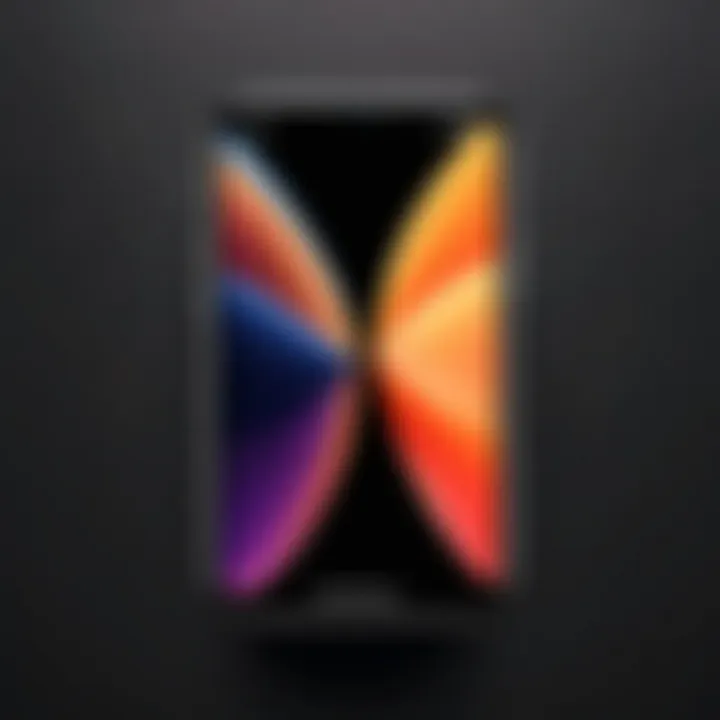Secure Your Images: Hide Photos on iPhone 11


Intro
In a world where privacy concerns loom larger than ever, knowing how to safely hide your personal photos on your iPhone 11 becomes essential. Whether you’re a tech-savvy individual wanting to keep your cherished moments secure or someone who simply wants to maintain a bit of whimsy in your digital life, managing photo visibility can be a game changer. This guide aims to dissect the methodologies at your disposal, offering straightforward steps and vital security tips.
You might think that merely putting your photos in a separate album is enough, but this guide will show you ways that add several layers to your photo security – perfect for those moments when you need to protect photos from prying eyes.
Overview of the Technology
The iPhone 11, with its superior hardware and iOS capabilities, is designed to give users peace of mind when it comes to managing their private images. Here’s a brief look at the tech that allows for seamless photo management:
Key specifications
- Display: 6.1 inches Liquid Retina HD display
- Chip: A13 Bionic chip for fast performance
- Camera: Dual-camera system for high-quality photography
- Storage options: Ranging from 64GB to 256GB
Unique selling points
- Face ID: Adds an extra layer of security
- iCloud: Considerably simplifies backup and accessibility
- Privacy features: Built-in photo hiding options within the Photos app
Design and Build Quality
Though it’s tempting to focus solely on functionality, the design of the iPhone 11 plays a significant role in user experience.
Material used
The device features a durable glass and aluminum frame, which not only lends it an elegant look but also contributes to its sturdy build. While aesthetically pleasing, the design also ensures that the iPhone 11 can handle the little accidents of daily life without too much risk of damage.
Ergonomics and usability
The iPhone 11 is designed to fit comfortably in your hand. The placement of its buttons and the size of the display allows for smooth navigation. Any feature, including those used to hide your photos, can be easily accessed without complicated maneuvers.
“In a sea of gadgets, the iPhone 11 manages to strike a balance between beauty and functionality.”
As we dive deeper into the functionality of the iPhone 11, the article will cover specific methods to effectively clutter-free your photo library and the importance of photo management in the digital age.
Foreword to Hiding Photos
In the world of smartphones, the iPhone 11 holds a prized spot due to its sophisticated features and user-friendly interface. One of the significant capabilities of this device is its photo management system, which, while robust, raises concerns about privacy for many users. Understanding how to effectively hide photos on the iPhone 11 isn’t just a matter of convenience; it’s about securing personal memories. With the rise of shared screens and prying eyes, knowing how to keep your images safe has become more critical than ever.
Understanding the Need for Privacy
Everyone values their privacy differently, especially when it comes to digital images. For some, these photos might be family moments, cherished memories, or sensitive information that must remain confidential. The importance of keeping such pictures hidden is clear; nobody wants to sift through their camera roll only to find moments of vulnerability exposed to curious friends or relatives. If you often hand your phone to someone for a quick glance, the risk of them stumbling upon personal photos can cause anxiety.
To put it bluntly, in a world where data breaches and privacy invasions are common, taking control of your images is empowering. Imagine casually showing a friend a cute pic and your thousands of selfies and candid shots pop up. Awkward, right? That’s why understanding the ins and outs of your device's capabilities to keep your photos out of sight is a smart move.
Overview of iPhone Photo Management
The iPhone 11 offers a host of features tailored to address management and privacy concerns. From its intuitive Photos app to secure options like iCloud, navigating through these tools efficiently can feel overwhelming if you aren't familiar with them. Here’s where we break it down.
The Photos app allows more than just snapping and storing images; it also organizes, shares, and protects them. Users can create albums and even hide entire collections with just a few taps. Additionally, understanding the relationship between local device storage and iCloud features enables better management of your photo library. With iCloud, for instance, you can seamlessly sync your photos across all Apple devices while ensuring privacy through specific sharing settings. It’s a double-edged sword, as it grants accessibility while also calling for responsible management.
In the course of this article, we will cover specific steps and crucial methods to help you navigate the tools available on the iPhone 11 for maintaining the privacy of your images. Unraveling these functionalities not only equips you with the know-how but also enhances your overall experience with the device, ensuring that your memories remain just yours.


Using the Photos App
The Photos app on your iPhone 11 serves as the core hub for photo management on your device, making it an essential topic when discussing how to hide photos. Its integral features allow users to organize, edit, and control visibility of images, reflecting a user-centric design focused on privacy and usability. Here, we will explore the various functionalities of the Photos app that can help keep your personal moments tucked away from prying eyes.
Creating a Hidden Album
Step-by-step Guide to Create a Hidden Album
Creating a hidden album in the Photos app is a fundamental approach to enhancing your privacy. To set one up, first open the Photos app, then navigate to the Albums tab at the bottom. Scroll down and tap on "+", where you will select "New Album". Give your album a name and hit "Save". You can then choose the pictures you wish to conceal and add them to this album. By doing this, you add an initial layer of security that keeps your private images away from the main library. The ability to create an album dedicated solely to hidden photos can relieve anxiety.
While this might seem like a simple process, it’s a popular choice because of its straightforward accessibility. However, it’s important to remember that hidden albums can still appear if someone knows how to navigate the Photos app. So while it provides a measure of privacy, it’s not foolproof and should be supplemented with other protective measures.
How to Add Photos to the Hidden Album
After creating a hidden album, it becomes crucial to understand how to effectively add photos to it. To do this, select the photos you wish to hide from your main library; tap on the "Share" icon, which usually looks like a box with an arrow pointing out. Then scroll down and select "Hide". This will transfer the images into the hidden album, ensuring they’re out of immediate sight. This process is seamless and user-friendly, making it a favored method for sorting sensitive images quickly. Keep in mind that the hidden album itself can still be accessed unless you apply additional security measures. Therefore, if someone knows their way around the device, they could potentially find those hidden photos.
Accessing the Hidden Album
Accessing the hidden album is quite simple. Just open the Photos app, go to the Albums tab, and scroll down to the "Hidden" section. While this ability makes it convenient for you to retrieve hidden images, the key here is awareness that this section is visible to anyone who might use your phone. It isn't disguised nor can it be password protected through the Photos app settings alone. Therefore, considering this method for hiding images means weighing the convenience against the risk of exposure. In summary, the hidden album is a practical feature but should ideally be part of a broader strategy for managing photo privacy.
Utilizing the Recently Deleted Folder
Understanding the Recently Deleted Functionality
In addition to creating a hidden album, the Recently Deleted folder is another layer of privacy offered by the Photos app. When you delete a photo, it doesn’t vanish into thin air; it moves to this folder, where it lingers for 30 days. This period allows for recovery if the deletion was accidental, yet it also serves a secondary purpose in your privacy strategy. If someone were to gain access to your device, they might browse this folder and uncover what you thought was permanently erased. Thus, it’s important to routinely clear out this folder or be conscious of what lingers in there.
Duration of Photo Residency in the Folder
The length of time that photos stay in the Recently Deleted folder—30 days—can feel like a blessing or a curse. After this period, photos will auto-delete permanently. This is beneficial because it provides a window for recovery without additional steps, but it also means that any harmful eyes could potentially see these images before they vanish for good. Those who are cautious about their privacy might consider regularly monitoring this folder and being proactive about erasing its contents if they contain sensitive material.
In essence, while the Photos app offers various avenues for hiding photos and managing privacy, it is important to implement strategies that ensure added layers of protection for your most private images.
Leveraging iCloud Features
Leveraging iCloud features is a crucial section in the realm of photo privacy on your iPhone 11. iCloud serves as a centralized hub for managing and safeguarding your images, allowing you to maintain a level of secrecy that many users desire. With its ability to sync across devices while offering options for privacy and security, it stands out as a valuable tool for anyone looking to keep their photos under wraps. Let’s dive deeper into specific elements that make iCloud a good option for photo management and the benefits that come with it.
Managing Photos with iCloud
Setting Up iCloud Photo Library
Setting up iCloud Photo Library enables users to seamlessly back up their images and videos while automatically organizing their media. This feature is particularly significant as it provides a robust safety net, ensuring your cherished moments are not just confined to your device. One of the key characteristics of this feature is its ability to keep the photos on all your Apple devices in sync.
What sets the iCloud Photo Library apart is the ease with which users can manage large volumes of images. The benefit of iCloud backing up your library means you can delete images from your device to free up space while knowing they reside safely in the cloud. On the flip side, users should be aware of their available storage space, as exceeding this can lead to additional charges. If you value photo preservation without the headache, iCloud Photo Library is a beneficial choice.
"In a digital age where memories are often organized in the cloud, ensuring their safety goes beyond conventional storage methods."
Disabling Photo Sharing with iCloud
Disabling photo sharing within iCloud is a wise step toward enhancing privacy. By doing so, you prevent your photos from being shared across linked devices or family accounts inadvertently. This control not only limits the visibility of private moments but also secures your images from unintended eyes.
The standout feature of disabling photo sharing is that it allows for tailored visibility, protecting your image library effectively. It can be tricky, as forgetting to disable sharing options might lead to those awkward situations where private photos become accessible to others. This proactive measure helps in limiting exposure, making it a smart strategy for those who prioritize their privacy.
Private Gallery Options


Exploring Third-Party Apps for Privacy
Exploring third-party apps for privacy can be a game changer for anyone looking to bolster their photo security. Apps like Keepsafe and Secret Photo Vault allow users to create private galleries that add an extra layer of concealment to their digital memories. These apps often come with unique features, such as the ability to encrypt photos and even set a password for accessing them.
The benefit here is the enhanced control over who gets to see your personal images. However, it’s essential to choose apps from reputable developers to mitigate any risks. Sometimes, while handy, these apps can potentially expose users to privacy concerns if not properly vetted. Still, for those engaged in safeguarding personal snapshots, third-party apps often prove to be beneficial resources for maintaining privacy.
Benefits of Using Private Gallery Apps
The benefits of using private gallery apps range from enhanced privacy to easy functionalities that everyday users appreciate. They are designed specifically to ensure that your images are shielded from prying eyes. A significant characteristic is their user-friendly interfaces, making it simple to move images into the app and organize them systematically.
One unique feature offered by many of these apps is the ability to hide the app itself from the home screen. This added privacy measure makes it harder for anyone to even see that the app is installed, eliminating any curious glances. Nevertheless, one must weigh the ease of use against potential subscription fees, as some apps may require a monthly or annual fee for optimal functionality. Altogether, private gallery apps can be a solid choice for users wanting to maintain their image privacy confidently.
Setting Up Device-Level Security
In an age where privacy is paramount, understanding how to fortify the security of your digital assets is crucial. The iPhone 11 offers a suite of features that can enhance the safety of your personal photos. Enabling device-level security can safeguard your visual memories against prying eyes and unauthorized access.
When folks think about securing their photos, they often forget that the best wall is a strong door. Setting up security measures not only protects your images but also instills confidence in how you manage your device overall. Security could mean knowing that even if someone gains access to your device, they won't be able to peek at your private albums.
Utilizing Face or Touch
Enabling Face /Touch for Photos App
The notion of using biometric security like Face ID or Touch ID for your Photos app provides an extra layer of assurance that many users find appealing. It’s certainly a key feature within iOS security protocols. By enabling this option, you’re not just protecting your photos but solidifying the overall privacy of your device. Each time you access your images, Face ID or Touch ID acts as your bouncer, only letting in those who have the right look or touch.
To enable these features, navigate to Settings > Face ID & Passcode or Touch ID & Passcode and set it up for applications, which includes the Photos app. You’ll find this straightforward process takes only a few minutes.
The unique aspect of biometrics is its speed and convenience. Unlike traditional passwords or pin codes, biometric methods ensure quick access to your photos without the hassle of remembering long strings of characters. However, they do come with drawbacks. For instance, if you have a cold or facial recognition struggles with different angles, it might prove frustrating.
Benefits of Biometrics in Securing Images
Biometric security features offer a modern, user-friendly way to protect your personal media. The ease of just looking at your device or placing your finger on it is a game changer, especially when your hands might be full or when you’re in a hurry. This layer of security seamlessly integrates into your routine, making it a popular choice among tech-savvy individuals.
Moreover, the unique trait of biometrics is that it’s significantly hard to duplicate. Unlike passwords which can be guessed, your facial structure or fingerprints are intrinsically yours. This characteristic boosts the safety of your private images. Yet, no system is foolproof. Biometrics, while highly effective, still have their limits. Factors like poor lighting or injury might hinder access, causing inconvenience at times.
Locking the Photos App
Using Screen Time to Restrict Access
Another consideration for securing your photos is using the Screen Time feature. This entails setting up restrictions that can filter access to the Photos app entirely. To do this, head over to Settings > Screen Time > App Limits, and from there, the process allows you to determine specifically what apps you want to restrict. This is particularly useful if you’re sharing your iPhone with family or friends and want to keep your private albums under wraps.
What's notable here is the ability to customize exactly how long or when someone can access the Photos app. Setting up Screen Time not only serves as a restriction but also promotes mindful usage of your device, which can be beneficial for everyone involved. It’s a small step for privacy but a giant leap for keeping your visual life safe. However, once set, you can’t easily circumvent it if you forget the limit settings.
Exploring Parental Controls for Enhanced Security
For users with children or younger family members, the concept of parental controls can take security a step further. Utilizing these features allows guardians to check what kids can access on their devices, effectively locking the Photos app among other applications. This adds an extra layer of control over how images are viewed by young eyes.
This is particularly useful for ensuring that the photos stored remain private. The interface to set this up is relatively simple: navigate to Settings > Screen Time again, and select Content & Privacy Restrictions. This choice allows for a more tailored approach to privacy, easing the worries of adults while ensuring that children use their devices appropriately.
However, while these parental controls provide great safety, sometimes they can be a hassle to maintain. There’s always the risk that your settings might inadvertently restrict access to legitimate apps, requiring regular checks.
In summary, setting up device-level security not only acts as a deterrent against unwanted access but also gives the user forceful control over who sees what. By utilizing biometric features and app restrictions, your photos remain in good hands, quite literally—because when it comes down to it, keeping your private life private is all about taking clear, confident steps.


Other Considerations for Photo Privacy
When diving into photo privacy on your iPhone 11, it’s essential to look beyond the basic methods of hiding images. The concept of privacy doesn’t just stop at concealing your snaps; it extends to maintaining a broader awareness of how your settings can affect your security and personal space. Regularly reviewing your photo management settings and recognizing potential threats are crucial for safeguarding your digital memories.
Regularly Reviewing Photo Settings
Maintaining a keen eye on your photo settings can save you from unintended exposure of personal images. This is where the importance of regularly reviewing photo settings comes into play.
Checking Sharing Settings
Setting up sharing on your phone is convenient, but it also opens doors to unwanted scrutiny. Checking sharing settings allows you to control, at a granular level, who has access to your images. You may have a shared album with friends that could inadvertently include sensitive content. Regularly checking these settings ensures that only those you trust get a glimpse of your cherished images.
A key characteristic of this approach is its accessibility. You don’t need to be a tech whiz to navigate these settings — they are designed to be user-friendly. However, the downside is not every individual takes the time to check these settings regularly, which can lead to accidental leaks. Additionally, if you disable a shared album without notifying participants, it could create confusion and lead to potential conflicts. Being proactive is beneficial in this context; it can prevent situations where photos you thought were private might actually be out in the open.
Monitoring Access Invitations
Closely related to checking sharing settings, monitoring access invitations tells you who’s been given permission to look at your photos. This is particularly vital when you use collaborative albums or share with family members. Anyone who receives such an invitation can significantly impact your photo privacy, especially if the content is sensitive.
When you take stock of these invitations, you become aware of who can access your albums. This vigilance is a beneficial choice highlighted in this article, as it allows for precision control over your digital space. But, remember, if you don’t revoke invitations timely, there’s a chance ex-partners or former friends might still be peeking at what you shared long ago. So this nuance adds a layer of importance to your overall strategy for maintaining privacy.
Recognizing Threats to Photo Security
No strategy for photo privacy is complete without acknowledging potential threats. Understanding what risks are present helps you to formulate a more robust defense.
Understanding Social Media Risks
Posting images on social media can be a double-edged sword. On one hand, you've got the joy of sharing your vibrant life with friends and family. But on the other, there are real risks associated with Understanding Social Media Risks. Once an image is out there, it can be challenging to control where it goes next. For illustration, think about how a photo shared with one person can be saved, screen-shotted, or even reposted without your permission.
The key characteristic of this risk is its pervasive nature. While countless people engage with social media, not all think twice about the potential consequences of what they upload. This is where having a savvy understanding of who can see what becomes imperative. While the benefit of social media can enhance communication and connection, the risks can lead to personal breaches that one may never fully recover from. Managing what gets shared and being wary of audience exposure should be a foundational element of digital photo management.
The Importance of Software Updates
Keeping your iPhone's software up to date often feels like a chore, but The Importance of Software Updates cannot be overstated. Updates frequently contain security patches that protect your device from vulnerabilities, some of which could potentially expose personal images.
An important feature of regular updates is that they fortify your device against emerging threats. Skipping these updates might leave gaping holes through which malicious elements can exploit your system. The benefits far outweigh any minor inconvenience faced when downloading and installing these updates. Ensure your privacy remains intact by staying ahead of potential threats.
Key Takeaway: A vigilant approach to both settings and potential threats ensures your photo privacy is prioritized. Regular reviews and updates can keep your personal moments safe from unwanted eyes.
Closure
In wrapping up our discussion on safeguarding your images on the iPhone 11, it's crucial to underscore the paramount importance of privacy. In today's digital age, where personal information can be just a click away, taking proactive measures to protect your photos isn’t just smart—it’s absolutely necessary. This article has traversed the various options iPhone 11 users have to ensure their personal images remain confidential. From utilizing the built-in features of the Photos app to employing security measures like Face ID and app locking, every layer you add brings a sense of control over who sees what.
Reiterating the Importance of Privacy
Privacy is a significant concern for many people, especially when it comes to sensitive images. Every day, we capture moments that we may not want to share with the world, be they personal memories or crucial documents. Failure to safeguard these items could lead to unintended exposure, whether that be through a shared family device or a misconfigured app. Users must remember that even a seemingly simple photo can hold value beyond its visual appeal—think of confidential documents, sensitive family moments, or anything you wouldn't want circulating.
"In a world where information is gold, protecting your personal data is the first step in preserving your integrity."
Taking advantage of the tools at your disposal allows you to create barriers between your private life and prying eyes. The practices we’ve highlighted—from creating hidden albums to using iCloud effectively—serve not just as measures of convenience but as essential aspects of modern digital living.
Encouragement for Enhanced Utilization of Device Features
The iPhone 11 is equipped with an arsenal of features designed for your comfort and security, yet many users may not be fully aware of how to leverage these tools effectively. It’s all too easy to let notifications distract you from customizing your settings or to dismiss device security as too cumbersome. Embrace the resources your device has to offer, and regularly review your privacy settings.
Consider integrating apps that offer additional privacy measures if you frequently deal with sensitive photos. Remember, the first line of defense starts with you taking control of your photo library and becoming proactive about your privacy.
Stay informed and engaged with features as Apple updates its software, ensuring optimal protection for your cherished images. As technology continues to evolve, so too should our approaches to privacy and security.







